Toshiba RAS-07SKHP-E
Table of contents
Disposal
Name of each part
Choice of operating modes
Helpful Hints
Cleaning your air conditioner
When the air conditioner will not be used for a long time (At the end of the season of use)
Precautionary measures
Disposal
This appliance is manufactured using materials that can be reused. Therefore, check with your local authorities on how to dispose of it in your area.
Name of each part
Outdoor unit
1 - On the rear and side surfaces, air is taken to the heat exchanger.
2 - Air exhaust from the heat exchanger.
indoor unit

1 - Openings for air intake on the upper surface.
2 - Window for receiving commands from the remote control.
3 - Air outlet from the indoor unit.
Remote controller remote control

Preparation before starting work
Installation work, as well as connection to the network, must be carried out by specialists with experience.
The connection must be made to an outlet of the required power rating, grounding must work.
Connect the plug to the socket with dry hands.
Set the time on the remote.
Choice of operating modes
The Toshiba RAS-07SKHP-E air conditioner model has the following operating modes.
Automatic maintenance of temperature. In this mode, the air conditioner maintains the temperature according to the values you set. When the temperature drops, heating is activated; when it is exceeded, cooling is activated.
Room heating. When using this mode, it should be remembered that the start of the fan of the indoor unit will not occur immediately after pressing the button on the remote control, but after the heat exchanger has warmed up. This protects against cold air blowing. In addition, in this mode, the outdoor unit is supercooled, so the operation of the air conditioner periodically stops to defrost the outdoor unit.
Room cooling. In this mode, the temperature in the room is maintained no higher than the one you specified. At the same time, the air is dried.
Drying out the room. In this mode, it is impossible to specify the desired temperature, since the program is aimed at dehumidifying the air with minimal cooling.
Room ventilation - in this mode, air circulation is maintained in the room.
Additional modes and settings
For a comfortable night's sleep, night mode is provided. It is quieter and can be used at night.
The timer allows you to select the on and off time. It is possible to set up to 12 on-off cycles.
For faster heating-cooling of the room there is a TURBO mode.
Self-diagnosis - in the event of a malfunction, the air conditioner can independently diagnose its condition.
Automatic Resume - If a power failure occurs while operating in any mode, then after power is restored, work will automatically continue in the same mode.
Helpful Hints
. When cooling a room, you should not lower the temperature to too low numbers - this is unhealthy and leads to energy waste.
. Close blinds or curtains in an air-conditioned room - direct sunlight will heat the air in the room and interfere with the operation of the air conditioner.
. Watch the position of the vertical damper - when heating, it should be vertical, when cooling - horizontal.
. Keep the air filter clean - if it is dirty, it will interfere with the operation of the air conditioner.
. Close windows and doors indoors to cold air did not leave the room. Additionally, make sure to ventilate the room in time, as the air conditioner only cools, but does not renew the air.
. To cool the air in the room faster, turn on the TURBO mode at the beginning of the air conditioner operation.
Cleaning your air conditioner
Do not use for cleaning hot water, detergents with abrasive particles, solvents. This can ruin the look of the plastic.
Use a stable base.
Before cleaning, turn off the air conditioner with the remote control and remove the plug from the socket.
All components must be dried after cleaning in the shade.
If you think there is a problem
The air conditioner doesn't work. Check if the plug is plugged into the socket, if there is power in the network, if there is a sleep timer that turned off the device.
The device cannot be turned on 3 minutes after being turned off. This is the job of protecting against frequent inclusions. Please wait and try again in three minutes.
During dry operation, the indoor unit turns off intermittently. Since the main purpose of this mode is to dehumidify the air with minimal cooling, the indoor unit fan will not run all the time.
Mist comes out of the indoor unit. If the indoor air is too humid, mist will appear around the cold air coming out of the indoor unit.
White smoke comes out of the outdoor unit. In heating mode, cold air is blown out of the outdoor unit, which causes droplets in the air that look like smoke.
During heating operation, the indoor unit turns off for 10 minutes. This is necessary to defrost the outdoor unit, which is covered with ice in this mode.
After the appearance of power in the network, the air conditioner itself earned. If before the emergency shutdown it worked in any of the modes, then after the appearance of voltage in the network, it will continue to work independently in the same mode.
Water is leaking from the outdoor unit. When heating and cooling air in outdoor unit there will be elements on which condensation will appear.
The air conditioner does not heat/cool well. Check if the windows and doors in the room are closed. Are there appliances that generate heat? Is the correct operating mode selected? Are the air filters clogged?
The air conditioner does not heat/cool. This is possible with a refrigerant leak - call specialized help.
The remote control does not work. Check the condition of the batteries - their correct installation. Replace if necessary.
A crackling sound is heard - with temperature fluctuations, the plastic will change size, which will cause such sounds.
A gurgle is heard. The movement of refrigerant and condensate can cause these sounds.
When the air conditioner will not be used for a long time
Before shutdown
Turn on the heat for three hours to dry out the cavity and stop fungal growth.
Turn off the air conditioner, remove the plug from the socket.
Remove the batteries from the remote control.
Before switching on
Check that there are no airflow obstructions in front of both units.
Install the batteries in the remote control.
Connect the plug to the socket with dry hands. Check for grounding.
Installation site and electrical work
The outdoor unit makes noise during operation and condensate must be removed from it, which should be taken into account when choosing a place.
Installation must be carried out by experienced professionals.
It should not be installed in places where there are volatile combustible substances, hydrogen sulfide, oil, high-frequency equipment.
Precautionary measures
Do not connect the plug of the air conditioner to an extension cord or socket with insufficient power.
Connect the air conditioner to the mains with dry and clean hands.
Do not pull, jerk, modify, repair the power cord and air conditioner yourself.
Do not place hard, hot or heavy objects on the cord.
Do not stand on your own or place other objects on the indoor and outdoor units.
Do not insert fingers, pens, pencils into the openings on the air conditioner case, as this may cause injury.
If there are oddities in the operation of the air conditioner, turn it off, disconnect the plug from the outlet and call specialists.
If the air conditioner is not cooling or heating, it may be due to a refrigerant leak. Disconnect it from the network and call specialists.
Do not spray flammable substances or insecticides around or on the air conditioner. This may cause fire and fire.
Do not expose people or animals to prolonged exposure to cold air.
Do not use the air conditioner for a long time in high humidity.
Do not direct airflow towards fire. This can lead to the appearance of products of incomplete combustion in the air.
After several seasons of using the air conditioner, it should be inspected.
Unplug the appliance from the mains during a thunderstorm
Exceptional build quality, the best operating parameters and thoughtful functionality are presented in Japanese air conditioners, which not only cool or heat, but also actively purify the air, creating a healthy and comfortable indoor atmosphere.
Product range overview
This trademark offers a wide range of two-component (split) and multi-split systems with different types of indoor modules, multi-zone VRF installations and heat pumps.
TOSHIBA's Component System Lineup has several lines of compressor inverter controlled air conditioners, which have gained the most popularity among customers due to their energy-saving operation. This was achieved due to the fact that the device operates continuously, without unnecessary switching off and on, and the power is regulated depending on external conditions, to which the DC compressor easily adapts.
Wall split systems
In wall splits, TOSHIBA inverter air conditioners in the N3KVR series, in addition to stylish design and minimal cost for electricity, have a powerful filtration system with several levels of purification.
These are the only climate control units on the market today that have a true purifier built in. It is capable of processing air several times faster.
Additionally, the system is equipped with ionic, antibacterial and plasma filters - this is a complete protection against bacteria, viruses, dust, dirt, wool and pollen in other series of inverters.
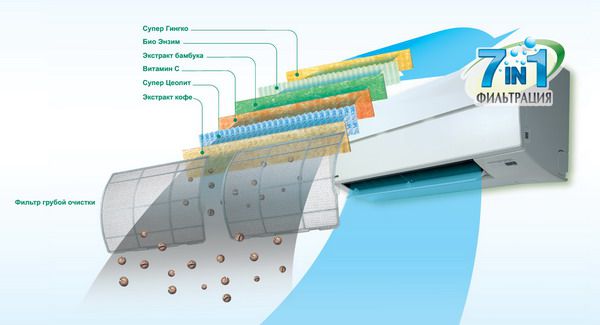
The functional features of TOSHIBA standard and inverter wall-mounted air conditioners include:
- fast achievement and precise maintenance of the set temperature parameters;
- low noise level of both blocks;
- the possibility of some series of devices to work at -20 ° C on the street;
- the use of safe type freon in most devices;
- dry mode;
- the presence of a timer for a day, the mode " Night sleep”, self-diagnostics and automatic mode change.
The color performance of wall split systems is quite diverse. White, silver and black panels of indoor units can fit into any interior.
For two-component splits and multi-split systems, the installation may include not only wall-mounted indoor units, but also cassette, channel, console ones.
Cassette split systems
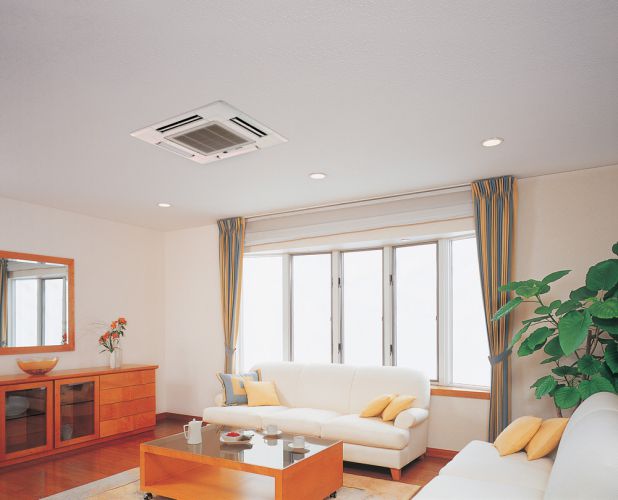
TOSHIBA cassette air conditioners are mainly represented by 4-way models of standard and more compact sizes. They are easily integrated into the hanging cell. ceiling structure and distribute air volumetrically in several directions. This causes the absence of drafts in the room and the cleanliness of the distribution grid itself - dust does not collect on it.
Compact cassette units comply with energy class A, while having high cooling and heating performance, reaching 11.2 kW. The noise is like a human whisper. This type of equipment is best suited for rooms with ceilings from 3.5 m and an area of up to 125 m².
Catechin filter, automatic mode switching, easy access for preventive maintenance, many modes and settings make this manufacturer's cassette air conditioners very convenient to use.
Duct split systems
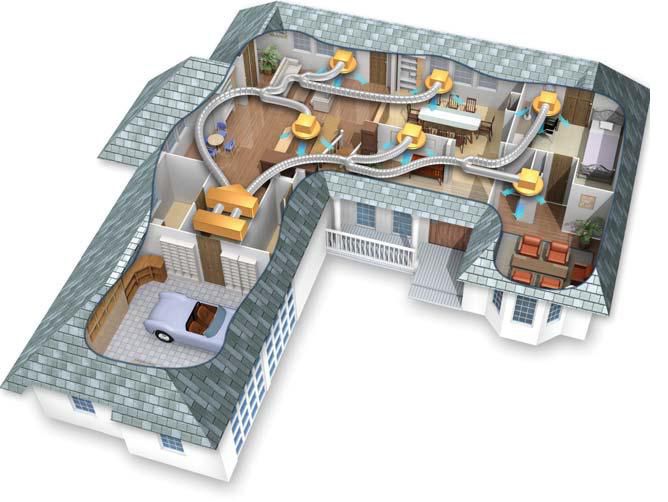
The air duct system of TOSHIBA ducted air conditioners is characterized by the fact that the air distribution devices can be installed anywhere, and this allows air to be supplied to rooms of any shape. The entire structure is hidden in a false ceiling, so the interior is not disturbed in any way.
All channel devices of this brand (medium and high pressure) are energy efficient, increased external static pressure and smooth distribution of air flows. There is a built-in drainage pump, allowing to drain condensate to any place, which, if necessary, is installed in the device.
The duct-type air conditioning system can not only recirculate the air in the room, but also mix in fresh air from the street, as well as cool several neighboring rooms at once.
Console split systems
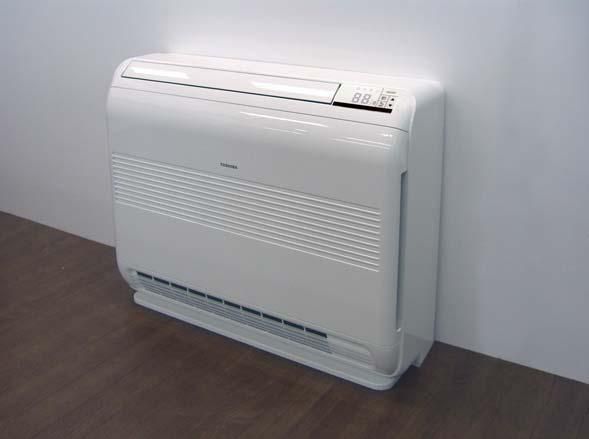
Dual mounting and design of console (floor-ceiling) air conditioners of this brand makes them convenient to use and easy to install. They don't take up too much space. The indoor unit is mounted either on the wall just above the floor or on the ceiling. Such an air conditioner does not require any suspended structures or air ducts, unlike cassette and channel splits, but it has almost the same power and temperature maintenance accuracy.
Console systems have many convenient modes and functions, namely:
- dehumidification and ventilation;
- floor heating mode;
- blinds adjustment;
- on and off timer;
- economy mode.
This climate equipment can be used as heating radiators if you install the module under the window.
Multi-split and multi-zone systems
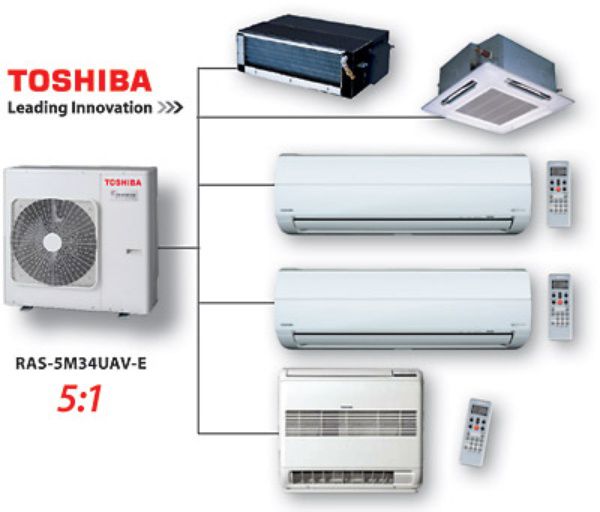
Multi-block (multi) split system allows you to cool and heat up to five adjacent rooms at the same time. From 2 to 5 room units are connected to one outdoor unit. TOSHIBA has both inverter and non-inverter air conditioner series for multi-split combinations. Devices can be used as internal modules various types. Economical electricity consumption, power, noiselessness, active filtering and versatility are the main advantages of this manufacturer's multi-block systems. For large buildings, TOSHIBA provides multi-zone VRF systems with variable refrigerant flow. They can combine up to 4 outdoor and 48 different types of indoor modules.
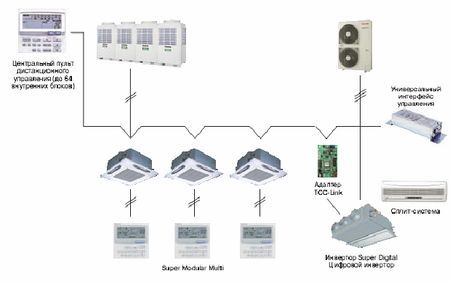
There are 3 series of multizone systems that differ in power characteristics: SMMS mini - up to 15 kW, SHRM - 48 kW, SMMSi - 150 kW. At the same time, all components of these systems, connected by a single connecting highway, can be combined with each other.
More favorable cost of operation, many functions, 3 control options (individual, centralized and network), maintaining the temperature with maximum accuracy, meeting the needs of several dozen rooms with completely different requirements - these are the main features of VRF systems from this Japanese company.
All devices are exclusively Japanese assembly. The main part of TOSHIBA air conditioners is able to operate at temperatures up to -15-20°C in winter without any failures.
Marking
The cipher from a set of letters and numbers is the marking or index of TOSHIBA air conditioners, which indicates differences from each other not only in type and series, but also in technical and functional parameters.
No company currently has uniform standards for letter marking. It may vary depending on the year of manufacture of the product and even small innovations in the control board. But all this data is extremely important in the operation and maintenance of the device.
All that the buyer needs to understand is the differences between TOSHIBA air conditioners according to the index in digital notation.
Codes 07, 10, 13, 16, 18, 24, 30 in the marking usually correspond to the maximum power that an air conditioner can achieve when working for cooling. These codes will correspond to 2 kW; 2.5 kW; 3.5 kW; 4.5 kW; 5 kW; 6.5 kW and 8 kW.
For all the rest distinctive features TOSHIBA air conditioners on the buyer's index can be consulted by managers in the store or employees of the official representative office in Russia.
Repair and spare parts

Malfunctions of devices from this manufacturer are extremely rare. In most cases, breakdowns occur due to non-compliance with the rules of installation and operation according to the instructions.
Repair work on the replacement of spare parts and cleaning of TOSHIBA air conditioners should be carried out only by a qualified technician, since Japanese climate control devices have the most complex design features.
As practice shows, the malfunctions detected by the user are not so significant and require little intervention by the repair team. Typically, people may experience:
- the air conditioner "flows" or blows warm air;
- light indication does not work;
- automatic restart of the system is constantly triggered;
- the remote control does not work;
- modes switch too slowly, the device “thinks” for a long time.
Most often in such cases, fixing the problem may require:
- refueling with freon;
- cleaning the drainage system;
- cleaning the air filters of the indoor module;
- elimination of problems with electronics;
- replacing the battery in the remote control.
If you suspect a malfunction, you should immediately call the appropriate services and read the instructions.
Serious breakdowns of TOSHIBA air conditioners require replacement of such parts as compressor, magnetic starter, outdoor unit capacitor, control board, 4-way valve and so on.
To avoid the replacement of expensive spare parts, regular preventive maintenance should be carried out and the operating instructions should be followed. If these requirements are not observed by the buyer, the manufacturer does not bear any responsibility for the equipment.
Remote control instructions
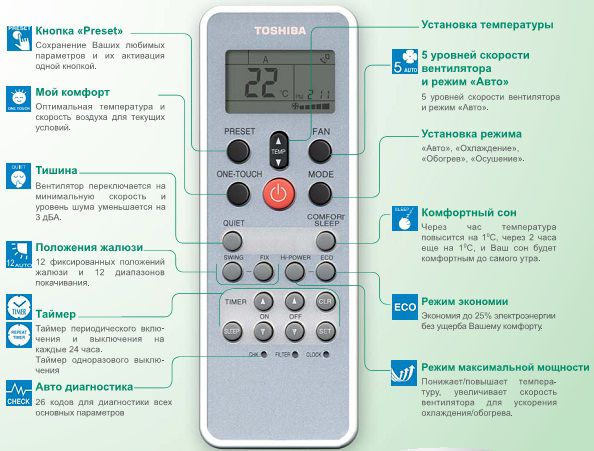
You can familiarize yourself with all the modes and functions of air conditioners in detail and in an accessible form using the instructions for the Toshiba air conditioner remote control. To begin with, it is worth studying the information about all the keys (indicators) of the device - there are a lot of them. And although the device itself is quite informative, it will be difficult to figure out how to turn on the timer or high power mode without the appropriate documentation.
The instructions for the remote control say that the TOSHIBA air conditioner can be controlled using the panel on the unit itself in the event of a malfunction of the remote control device.
It should be remembered that the automatic restart operation is not initially programmed at the factory, so it should be activated on the device by the user himself. Any Toshiba air conditioner remote control contains instructions on how to do this.
Instructions for the following models:
Toshiba RAS-07SKHP-E
Toshiba RAS-10SKV-E2
Toshiba Air Conditioner RAS-07SKHP-E
Table of contents
Disposal
Name of each part
Choice of operating modes
Helpful Hints
Cleaning your air conditioner
Precautionary measures
Disposal
Name of each part
Outdoor unit
indoor unit


MAIN FUNCTIONS
The new remote control RAS-SKHP-E is designed with comfort and ergonomics in mind. Frequently used buttons are placed at the top, and function control buttons are located below.
Preparation before starting work
Installation work, as well as connection to the network, must be carried out by specialists with experience.
The connection must be made to an outlet of the required power rating, grounding must work.
Connect the plug to the socket with dry hands.
Set the time on the remote.
Choice of operating modes
Model RAS-07SKHP-E has the following operating modes.
Automatic maintenance of temperature. In this mode, the air conditioner maintains the temperature according to the values you set. When the temperature drops, heating is turned on, when it is exceeded, cooling is turned on.
Room heating. When using this mode, it should be remembered that the start of the fan of the indoor unit will not occur immediately after pressing the button on the remote control, but after the heat exchanger has warmed up. This protects against cold air blowing. In addition, in this mode, the outdoor unit is supercooled, so the operation of the air conditioner periodically stops to defrost the outdoor unit.
Room cooling. In this mode, the temperature in the room is maintained no higher than the one you specified. At the same time, the air is dried.
Drying out the room. In this mode, it is impossible to specify the desired temperature, since the program is aimed at dehumidifying the air with minimal cooling.
Ventilation in the room - in this mode, air circulation is maintained in the room.
Additional modes and settings
For a comfortable night's sleep, night mode is provided. It is quieter and can be used at night.
The timer allows you to select the on and off time. It is possible to set up to 12 on-off cycles.
For faster heating-cooling of the room there is a TURBO mode.
Self-diagnosis - in case of malfunctions, the air conditioner can independently diagnose its condition.
Automatic resumption of work - if an emergency power failure occurs during operation in any mode, then after the power is restored, work will automatically continue in the same mode.
Helpful Hints
When cooling a room, you should not lower the temperature to too low numbers - this is unhealthy and leads to energy waste.
Close blinds or curtains in an air-conditioned room - direct sunlight will heat the air in the room and interfere with the operation of the air conditioner.
Watch the position of the vertical damper - when heating, it should be vertical, when cooling - horizontal.
Keep the air filter clean - in a dirty state, it will interfere with the operation of the air conditioner.
Close windows and doors indoors to prevent cold air from leaving the room. Additionally, make sure to ventilate the room in time, as the air conditioner only cools, but does not renew the air.
To cool the air in the room faster, turn on the TURBO mode at the beginning of the air conditioner operation.
Cleaning your air conditioner
Do not use hot water, abrasive cleaners or solvents for cleaning. This can ruin the look of the plastic.
Use a stable base.
Before cleaning, turn off the air conditioner with the remote control and remove the plug from the socket.
All components must be dried after cleaning in the shade.
If you think there is a problem
The air conditioner doesn't work. Check if the plug is plugged into the socket, if there is power in the network, if there is a sleep timer that turned off the device.
The device cannot be turned on 3 minutes after being turned off. This is the job of protecting against frequent inclusions. Please wait and try again in three minutes.
During dry operation, the indoor unit turns off intermittently. Since the main purpose of this mode is to dehumidify the air with minimal cooling, the indoor unit fan will not run all the time.
Mist comes out of the indoor unit. If the indoor air is too humid, mist will appear around the cold air coming out of the indoor unit.
White smoke comes out of the outdoor unit. In heating mode, cold air is blown out of the outdoor unit, which causes droplets in the air that look like smoke.
During heating operation, the indoor unit turns off for 10 minutes. This is necessary to defrost the outdoor unit, which is covered with ice in this mode.
After the appearance of power in the network, the air conditioner itself earned. If before the emergency shutdown it worked in any of the modes, then after the appearance of voltage in the network, it will continue to work independently in the same mode.
Water is leaking from the outdoor unit. When heating and cooling the air in the outdoor unit, there will be elements on which condensation will appear.
The air conditioner does not heat/cool well. Check if the windows and doors in the room are closed. Are there appliances that generate heat? Is the correct operating mode selected? Are the air filters clogged?
The air conditioner does not heat/cool. This is possible due to a refrigerant leak - call for specialized help.
The remote control does not work. Check the condition of the batteries - their correct installation. Replace if necessary.
A crackling sound is heard - with temperature fluctuations, the plastic will change size, which will cause such sounds.
A gurgle is heard. The movement of refrigerant and condensate can cause these sounds.
When the air conditioner will not be used for a long time
Before shutdown
Turn on the heat for three hours to dry out the cavity and stop fungal growth.
Turn off the air conditioner, remove the plug from the socket.
Remove the batteries from the remote control.
Before switching on
Check that there are no airflow obstructions in front of both units.
Install the batteries in the remote control.
Connect the plug to the socket with dry hands. Check for grounding.
Installation site and electrical work
The outdoor unit makes noise during operation and condensate must be removed from it, which should be taken into account when choosing a place.
Installation must be carried out by experienced professionals.
It should not be installed in places where there are volatile combustible substances, hydrogen sulfide, oil, high-frequency equipment.
Precautionary measures
Do not connect the plug of the air conditioner to an extension cord or socket with insufficient power.
Connect the air conditioner to the mains with dry and clean hands.
Do not pull, jerk, modify, repair the power cord and air conditioner yourself.
Do not place hard, hot or heavy objects on the cord.
Do not stand on your own or place other objects on the indoor and outdoor units.
Do not insert fingers, pens, pencils into the holes on the air conditioner case, as this may cause injury.
If there are oddities in the operation of the air conditioner, turn it off, disconnect the plug from the outlet and call specialists.
If the air conditioner is not cooling or heating, it may be due to a refrigerant leak. Disconnect it from the network and call specialists.
Do not spray flammable substances or insecticides around or on the air conditioner. This may cause fire and fire.
Do not expose people or animals to prolonged exposure to cold air.
Do not use the air conditioner for a long time in high humidity.
Do not direct airflow towards fire. This can lead to the appearance of products of incomplete combustion in the air.
After several seasons of using the air conditioner, it should be inspected.
Unplug the appliance from the mains during thunderstorms.
Toshiba Air Conditioner RAS-10SKV-E2
Table of contents
Disposal
Name of each part
Preparation before starting work
Choice of operating modes
Additional modes and settings
Helpful Hints
Cleaning your air conditioner
If you think there is a problem
When the air conditioner will not be used for a long time (At the end of the season of use)
Installation site and electrical work
Precautionary measures
Disposal
This appliance is manufactured using materials that can be reused. Therefore, check with your local authorities on how to dispose of it in your area.
Name of each part
Outdoor unit
1 - On the rear and side surfaces, air is taken to the heat exchanger.
2 - Air exhaust from the heat exchanger.
indoor unit
1 - Air intake holes on the top surface.
2 - Window for receiving commands from the remote control.
3 - Air outlet from the indoor unit.
Remote control
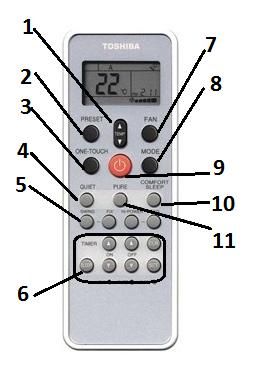
1 - Set the desired temperature level.
2 - Save settings.
3 - Work in the mode of previously set settings.
4 - Quiet mode of operation.
5 - Air outlet direction.
6 - Timer control.
7 - Fan control.
8 - Operating mode.
9 - Start-switch off the device.
10 - Mode of comfortable work at night.
11 - Energy saving
Instrument preparation
Install batteries in the remote control. Please note at that point that both batteries must be of the same type, charge level and non-rechargeable type. Do not connect the device to the mains through an outlet with insufficient power. Extension cords are not allowed.
Choice of operating modes
After turning on the device, the following modes will be available to you:
automatic maintenance of the set temperature range;
air heating;
cooling;
drainage;
ventilation.
Automatic temperature control mode. Great for every day - the device independently evaluates the current temperature and if its value differs from the one you set, it turns on heating or cooling.
If you want, you can use just heating or cooling. Unlike cooling, when dehumidifying, the device removes moisture from the air and has minimal effect on its temperature.
The ventilation mode is good in that simultaneously with maintaining air circulation, it is cleaned.
Additional Modes
Powerful and practical, the air filter stands out for its efficiency and a high degree of removal of dust particles from the air.
During operation, you can set the direction of air emission, select a quieter mode of operation of the device.
Thanks to the two-rotor inverter mechanism, this device is distinguished by an increased degree of efficiency and is much less noisy than other air conditioners.
Sleep mode will come in handy at night when everyone is sleeping.
To save your time, it is possible to save previously selected settings and then use them with one click of a button.
Auto restart is a very useful feature in case of a power failure. Your appliance will not need to be restarted if it has stopped working after an emergency shutdown - this will happen automatically.
Helpful Hints
If you are going to cool the room, then you should not cool it for a long time at maximum power. The device will spend too much energy and at the same time you risk harming your health.
Watch the windows and doors in the room - they must be closed so that the cooled air does not leave the room.
Keep an eye on the position of the curtains, blinds - direct sunlight will significantly heat the room, which will make it difficult for the device to work.
Dirty air filters will prevent the appliance from passing air through the indoor unit, which will reduce its efficiency.
At the beginning of work, it is necessary to turn on the fan operation on maximum power to reach the desired temperature faster.
Do not forget to periodically ventilate the room in order to return the oxygen content in it to normal values.
Cleaning the air conditioner
Don't forget to dissolve first. detergent in warm water. All actions with the device still connected to the network must be carried out exclusively with dry hands. Use a secure and stable support for cleaning. It is unacceptable to use gasoline, scratching particles, solvents, too hot water.
If you are having difficulty, contact your dealer and clarify the ambiguity.
If there is a suspicion that there is a malfunction
If you are unable to turn on the device, then first of all check whether it is connected to the network. There may be no mains power. Also, it often happens that the shutdown timer is taken as a malfunction.
If you cannot turn on the device immediately after turning it off, then this is not a cause for concern - this is the work of the system that protects the device from frequent starts.
When the room is cooled, the indoor unit and when heated, the outdoor unit emits cold air, which causes mist around the exhaust air.
Working in the air dehydration mode, the device tends to dry the air without cooling it. Therefore, your air conditioner will work in this mode not continuously, but with pauses.
When operating in heating mode, the unit will periodically stop operation to defrost the outdoor unit. Such pauses in work, lasting up to 10 minutes, are the norm.
If your device started working on its own when mains voltage appeared, this may be a manifestation of the automatic restart system. If the device was turned on before the emergency blackout, then after the power is restored, it will automatically continue to work in the same mode.
During any heat operation, there will be parts in the outdoor unit where condensation will occur, which may cause water to flow out of the appliance.
If the control panel does not work well, the image is fuzzy, has disappeared, then you need to check the presence of batteries, their correct installation in the slots, and the charge level.
If it is not possible to cool the room properly, you need to make sure that the basic requirements for the room where the air conditioner is working are met. Windows and doors should be closed to prevent cold air loss, however, do not forget to regularly ventilate the room to avoid the possibility of oxygen starvation. Regularly check the condition of the air filters - their contamination significantly impairs the operation of the device. It will not be superfluous to check if there is an error in choosing the operating mode of the device. If it is very hot outside, then the work to cool the room will be less effective.
If the air emitted from the indoor unit has a strange smell, it may indicate that there is contamination on the indoor unit, in the air filter or on the wall (carpet) near the air conditioner.
Thermal work will lead to plastic deformation and cracking, this is a normal phenomenon.
The movement of refrigerant and condensate will lead to the appearance of corresponding sounds - gurgling and splashing.
If the appliance stops working, there is a burning smell, smoke is visible, turn off the appliance immediately and disconnect the plug from the socket. Contact technical assistance.
When the air conditioner is out of use for a long time
Dry the appliance by running the heating mode for 1-2 hours. After that, you can disconnect it from the network and remove the batteries from the remote control.
More steps are required to reconnect. First you need to make sure that there are no obstacles for air movement near both blocks. Check the cleanliness of the air filter. Connect the device to the mains and check the operation of the ground. Install the batteries in the remote control.
Installation location
When choosing a place, you need to make sure that there is somewhere to drain water (condensate). It is also necessary to check that in this place the noise from the operation of the device will not interfere with the neighbors.
Do not use the device in places with a salty, humid climate. It is unacceptable to use it in rooms where the appearance of combustible substances, hydrogen sulfide is possible. Do not use the device in places where it is expected a large number of machine oil in the air.
Do not install the device too close to sensitive electronics, high frequency equipment.
Precautionary measures
This appliance must be connected to the mains power supply through an outlet with sufficient power. Check the presence and operability of grounding before starting operation.
It is unacceptable to independently repair, alter, modify the device and its components, the power cord.
All actions with the device that is connected to the power supply must be performed with dry hands.
Do not place objects (especially hard, sharp-edged and heavy objects) on the power cord.
Do not insert foreign objects into the openings of the air conditioner case. There is a high-speed fan running inside that could injure you.
Do not direct the cold stream towards yourself or other people.
It is not recommended to place electrical appliances and furniture under the appliance, as condensation may drip from it.
If the cooling process is completely broken, then it is necessary to check the device for refrigerant leakage.











Can't understand the meaning of life
Mate Brewing Methods
Trollface quest games Black humor games
Dark spots in photos?
Rules of the game Bald in VK. Scrabble nerd. The purpose of the game Balda